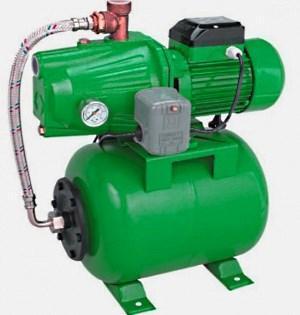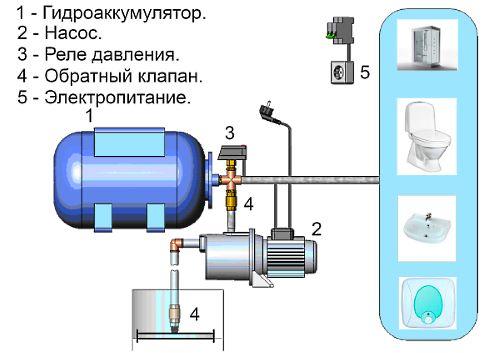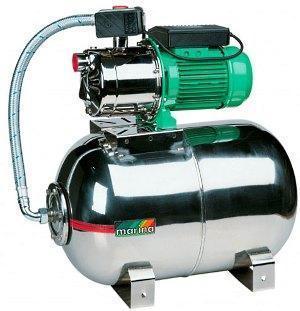How to choose a pumping station for a summer residence?
 The issue of water supply to the summer cottage is one of the main tasks of providing the amenities of the house. Pumping station for summer cottages - the main element for supplying water from the well to the interior of the room.
The issue of water supply to the summer cottage is one of the main tasks of providing the amenities of the house. Pumping station for summer cottages - the main element for supplying water from the well to the interior of the room.
The most popular unit for supplying water in a private area is a pumping station for a summer residence. It guarantees an uninterrupted supply of water from a well or a well to the house. The mechanism and device of the station are not complicated.
A complete water supply system consists of the following structural elements:
- pump (surface or borehole);
- expansion tank for water;
- relay controller (controls the operation of the pumping station);
- pressure gauge (used to measure the pressure inside the expansion tank);
- check valve (prevents backflow of water from the room);
- connecting hose.

The main parameters when choosing a pumping station are its technical characteristics:
- power,
- the ability to supply water from a source at a certain distance,
- water intake height,
- storage tank volume,
- performance.
Today there is a large assortment of selection of devices for providing country water supply. Each station has certain advantages that differ in their cost and quality indicators.
When choosing a station, consider the distance from the source to the house. The smaller it is, the less power the pumping station needs. The depth of occurrence of water masses in a well or in a well also plays an important role here.
Choosing the most powerful station is not always justified because its productivity can be much higher than the well itself can provide with water. Also, don't buy the most expensive device. It is necessary to find the best option, in accordance with the technical parameters and performance for a particular case.
Stable provision of water supply to the house for domestic purposes can provide a pump capacity of about 3000-6000 l / h, and for summer cottage needs this figure is 600-1000 l / h. The volume of the expansion vessel must hold at least 25 liters.
To ensure the supply of water to the house from a source up to 8 meters deep, the power of the station is sufficient from 0.8 to 1.2 kW / h. If the depth of the source is more than 8 m, then you need to use borehole pump in tandem with a pumping station, the indicators of which are equal to 1.5-2.2 kW / h.
The submersible borehole pump has a cylindrical shape and a metal, stainless steel body. It consists of a water supply device (screw or centrifugal), a compressor unit and a compartment for water intake with a protective mesh. In the upper part of the pump there is an outlet to which a check valve and a water supply hose are connected.
Each summer resident, having information about all the necessary parameters of a summer cottage, can freely calculate the necessary unit and make a choice of pumping stations for a summer residence.
Overview of pumping stations for country houses
After determining the type and type of country water supply device, it is necessary to review the pumping stations for country houses.
There are manufacturers who are constantly using innovative approaches to improve the quality of their products. It should be noted their reliability and a large selection of models for water consumption for summer cottages:
Pumping station CAM 40-22 Marina
 The model is equipped with a surface pump, which is equipped with a built-in ejector.The principle of water supply is carried out through an elastic tube, or a reinforced, strong water supply hose of large diameter (usually 25mm or 32mm). The end of the hose or tube is immersed in water. It is equipped with a non-return valve. On the pipe near the pump, some summer residents install a filter that prevents heavy substances from entering the internal water supply.
The model is equipped with a surface pump, which is equipped with a built-in ejector.The principle of water supply is carried out through an elastic tube, or a reinforced, strong water supply hose of large diameter (usually 25mm or 32mm). The end of the hose or tube is immersed in water. It is equipped with a non-return valve. On the pipe near the pump, some summer residents install a filter that prevents heavy substances from entering the internal water supply.
The first start-up of the station must be carried out in accordance with the recommendations from the instructions. Before starting, water is poured through a special hole with a plastic plug. It must fill the space between the pump check valve and the compressor itself.
The most popular brands that use remote ejector technology are:
- Wilo-Jet HWJ,
- Grundfos Hydrojet,
- Aquario.
Such pumps are intended to ensure the pressure of water from wells, the water mirror of which varies from 9 to 45 m. The connecting elements of such devices are two pipes.
ESPA TECNOPRES electron
 This pumping station is electronically controlled for safety and additional functions:
This pumping station is electronically controlled for safety and additional functions:
- protection against starting the pump without a sufficient water level in the source;
- prevention of frequent starts;
- adjustment of start and control of a smooth set of engine speed. Thanks to this system, a sharp water pressure is completely eliminated, at which a sudden high pressure zone (water hammer) can be created;
- energy saving;
The only drawback is the cost. Not every summer resident can afford to purchase such a pumping station.
Basic rules for connecting pumping stations
 The location of the water source is the main predetermination of the installation method of the pumping station. If it is close to home, you can set up a small indoor station. If at the same time the pump makes too loud sounds during operation, then the expansion tank should be placed in the room, and the pump should be placed in a well. For the winter, the opening of the well needs to be insulated.
The location of the water source is the main predetermination of the installation method of the pumping station. If it is close to home, you can set up a small indoor station. If at the same time the pump makes too loud sounds during operation, then the expansion tank should be placed in the room, and the pump should be placed in a well. For the winter, the opening of the well needs to be insulated.
It is also possible to connect the pumping station to the well through a special dug pit with a hatch near the source. In this case, the pit must be insulated, especially in the winter season.
The best option for giving, if the source is located at a distance of about 20 m from the house, will be the use of a deep pump. According to the rules for connecting pumping stations, such a scheme provides for laying pipes in the ground at a depth of at least 80 cm. The pipe must be laid on a sand cushion so that in case of subsidence of the earth, the pipe is not damaged. The pipe itself should be dressed in insulation.
The power cable enters the pump hermetically, therefore, power leakage is completely excluded. The other end of the wire connects to the expansion tank automation.
It is best to install the expansion tank in a room that is heated in winter - a bathroom or a kitchen. The tank does not create noise and has an aesthetic appearance, therefore it will fit into any interior. The inlet pipe is connected to the expansion tank, and the other part of the pipe is hermetically connected to the pump in the well.
Inside the room, the water supply system is plugged into an outlet, while the pump is activated and pumps water into the system. The pump is controlled by an automatic system.
Having such a system in the country, the issue of the amenities in the house is completely resolved. An autonomous water supply system is more a means of comfort than a luxury. Following the recommendations of specialists, you can easily install such a system even with your own hands.
Read also the article: pumping station for a private house - how to choose?
Good article, and most importantly, relevant. It is correctly written that, having such a system in the country, the issue of the amenities in the house is completely resolved.Previously, I suffered for a long time, having no conveniences in the country (it all consisted in the lack of water supply at home), did not know how best to implement it. Friends advised to install a pumping station. There have been no problems with water supply for several years now. I use a 1.5 kW submersible centrifugal pump "Aquarius". The depth of the well is about 8 m, it is located at a distance of 40 m from the house. I have an expansion tank for water in my bathroom. The system works great, provides water to the bathroom (shower, toilet, boiler, washing machine), kitchen. There are no failures in work. I recommend to everyone.